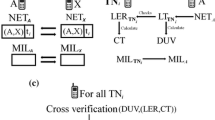Abstract
Unlike the conventional routing techniques in Internet where routing privileges are given to trustworthy and fully authenticated nodes, delay-tolerant networks (DTNs) allow any node to participate in routing due to the lack of consistent infrastructure and central administration. This creates new security issues since even authorized nodes in DTNs could inject several malicious threats into the network. This paper investigates the problem of mitigating blackhole attacks in DTNs based on the Spray-and-Wait routing protocol. A new knowledge-based routing scheme, called Trust-Based Spray-and-Wait protocol (TB-SnW), is designed based on distributed trust management. Each node maintains the trust levels for encountered nodes based on the message exchange history, and uses the trust levels to smartly distribute message copies to bypass blackhole attackers. Simulation results demonstrate that, compared with Spray-and-Wait, TB-SnW can achieve higher message delivery rate with very low communication overhead in DTNs that suffer from blackhole attacks.












Similar content being viewed by others
References
The opportunistic network environment simulator. URL http://www.netlab.tkk.fi/tutkimus/dtn/theone/
Aysha Al Hinai HZ, Chen Y (2012) Mitigating blackhole attacks in delay tolerant networks. In: Proceeding of the 13th international conference on parallel and distributed computing, applications and technologies (PDCAT)
Baruch A, Reza C, David H, Cristina NR (2004) Mitigating byzantine attacks in ad hoc wireless networks. Tech. rep., Department of Computer Science, Johns Hopkins University
Burgess J, Bissias GD, Corner MD, Levine BN (2007) Surviving attacks on disruption-tolerant networks without authentication. Proceedings of the 8th ACM international symposium on Mobile ad hoc networking and computing., MobiHoc ’07ACM, New York, NY, USA, pp 61–70
Chen IR, Bao F, Chang M, Cho JH (2010) Trust management for encounter-based routing in delay tolerant networks. In: Proceeding of IEEE the global telecommunications conference (GLOBECOM)
Cheng PC, Lee KC, Gerla M, Härri J (2010) GeoDTN+Nav: geographic DTN routing with navigator prediction for urban vehicular environments. Mobile Netw Appl 15:61–82
Chuah M, Yang P, Han J (2007) A ferry-based intrusion detection scheme for sparsely connected ad hoc networks. In: Proceedings of the 2007 fourth annual international conference on mobile and ubiquitous systems: networking&services (MobiQuitous), pp 1–8
Grasic S, Davies E, Lindgren A, Doria A (2011) The evolution of a dtn routing protocol-prophetv2. In: Proceedings of the 6th ACM workshop on challenged, networks, pp 27–30
Harras KA, Almeroth KC, Belding-Royer EM (2005) Delay tolerant mobile networks (DTMNs): controlled flooding in sparse mobile networks. In: Proceedings of the 4th IFIP-TC6 international conference on networking technologies, services, and protocols, pp 1180–1192
Huang YA, Lee W (2003) A cooperative intrusion detection system for ad hoc networks. In: Proceedings of the 1st ACM workshop on Security of ad hoc and sensor networks, New York, NY, USA, pp 135–147
Jones EPC, Li L, Schmidtke JK, Ward PAS (2007) Practical routing in delay-tolerant networks. IEEE Trans Mobile Comput 6(8):943–959
Juang P, Oki H, Wang Y, Martonosi M, Peh LS, Rubenstein D (2002) Energy-efficient computing for wildlife tracking: design tradeoffs and early experiences with zebranet. In: Proceedings of the 10th international conference on architectural support for programming languages and operating systems, pp 96–107
Li F, Wu J, Srinivasan A Thwarting blackhole attacks in disruption-tolerant networks using encounter tickets. In: Proceeding of IEEE INFOCOM, pp 2428–243
Lindgren A, Doria A, Schelén O (2003) Probabilistic routing in intermittently connected networks. SIGMOBILE Mob Comput Commun Rev, pp 19–20
Scott J, Gass R, Crowcroft J, Hui P, Diot C, Chaintreau A (2009) CRAWDAD trace cambridge/haggle/imote/infocom2006 (v. 2009-05-29). Downloaded from http://crawdad.cs.dartmouth.edu/cambridge/haggle/imote/infocom2006
Thrasyvoulos S, Konstantinos P, Raghavendra Cauligi S(2005) Spray and wait: an efficient routing scheme for intermittently connected mobile networks. In: Proceedings of the 2005 ACM SIGCOMM workshop on delay-tolerant networking, pp 252–259
Vahdat A, Becker D (2000) Epidemic routing for partially connected ad hoc networks. Tech. rep., Department of Computer Science, Duke University
Wu X, Chen Y, Xu M, Peng W (2012) TAFR: a TTL-aware Message Ferry Scheme in DTN. In: Proceeding of the fourth international conference on computational and information sciences (ICCIS), pp 1380–1383
Wu Y, Deng S, Huang H (2013) Evaluating the impact of selfish behaviors on epidemic forwarding in mobile social networks. J Stat Mech Theory Exp 02:1026–1028
Author information
Authors and Affiliations
Corresponding author
Rights and permissions
About this article
Cite this article
Al-Hinai, A., Zhang, H., Chen, Y. et al. TB-SnW: Trust-based Spray-and-Wait routing for delay-tolerant networks. J Supercomput 69, 593–609 (2014). https://doi.org/10.1007/s11227-014-1095-z
Published:
Issue Date:
DOI: https://doi.org/10.1007/s11227-014-1095-z




